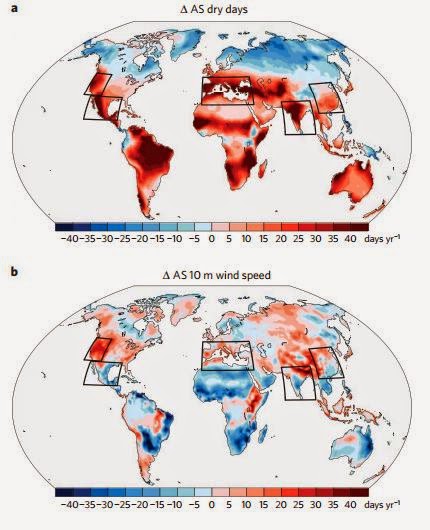
A new study conducted by researchers at Stanford University has led to findings indicating that much of the world can expect to have more atmospheric stagnation events as the future unfolds. In their paper published in Nature Climate Change, the researchers describe how they ran a variety of computer models that took into account a continued increase in greenhouse gas emissions—they report that taken together, the models predict that approximately 55 percent of the world’s population can expect to be impacted by future stagnation events.
Stagnation is an atmospheric phenomenon where an air mass remains in place over a geographic region for an extended period of time. They tend to happen due to the convergence of specific weather conditions—light wind patterns near the surface, other light wind patterns occurring higher up, and a lack of rain. During normal weather periods, wind and rain combine to clean the air around metropolitan areas—when rain fails to fall and there is little wind to push pollution away from an area, particulates and other types of pollution levels climb, putting those that live in the area at risk of health problems.
The collection of computer models run by the team at Stanford also suggest that stagnation events are likely to last longer—increasing by an average of 40 days a year. The result the team notes, is likely to be an increase in heart and lung complications in people in those areas, contributing to an associated climb in the number of premature deaths due to air pollutants—numbering perhaps in the millions. They also note that Mexico, India and parts of the western U.S. are likely to be most at risk of health impacts from an increase in stagnation events, as all three will have more and longer such events and all three are heavily populated.
The researchers suggest that at some point, the entire planet will be impacted by stagnation events. That means governments and health workers will need to make plans on how to handle the problems as they begin to occur. They add that the only real solution to the problem is to begin curbing greenhouse gas emissions now, preventing the events from occurring in the first place.
More information: Occurrence and persistence of future atmospheric stagnation events, Nature Climate Change (2014) DOI: 10.1038/nclimate2272
Abstract
Poor air quality causes an estimated 2.6–4.4 million premature deaths per year. Hazardous conditions form when meteorological components allow the accumulation of pollutants in the near-surface atmosphere. Global-warming-driven changes to atmospheric circulation and the hydrological cycle are expected to alter the meteorological components that control pollutant build-up and dispersal, but the magnitude, direction, geographic footprint and public health impact of this alteration remain unclear. We used an air stagnation index and an ensemble of bias-corrected climate model simulations to quantify the response of stagnation occurrence and persistence to global warming. Our analysis projects increases in stagnation occurrence that cover 55% of the current global population, with areas of increase affecting ten times more people than areas of decrease. By the late twenty-first century, robust increases of up to 40 days per year are projected throughout the majority of the tropics and subtropics, as well as within isolated mid-latitude regions. Potential impacts over India, Mexico and the western US are particularly acute owing to the intersection of large populations and increases in the persistence of stagnation events, including those of extreme duration. These results indicate that anthropogenic climate change is likely to alter the level of pollutant management required to meet future air quality targets.
Note : The above story is based on materials provided by © 2014 Phys.org










